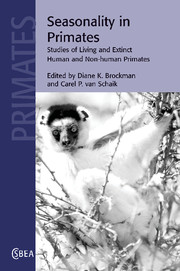Preface
Published online by Cambridge University Press: 10 August 2009
Summary
Animals everywhere have to cope with the changing seasons. Even those living in the tropics face serious fluctuations in the abundance of their favorite foods. In this book we examine how seasonal variation in food supply affects what primates eat, where they search for it, how active they are, and when during the day they are active, as well as how these responses affect their body sizes, their social lives, the timing of their reproduction, and the composition of their ecological communities. For the first time, we distinguish several general patterns about these seasonal responses. These generalizations are subsequently applied to see whether major transitions during hominin evolution can be ascribed to dramatic changes in seasonality.
The contributors to this book were selected from among internationally recognized primate field biologists and behavioral ecologists who presented synthetic review papers on how seasonality influences intraspecific variation in primate behavior and socioecology at the Primate Seasonality Symposium during the XVIII Congress of the International Primatological Society in Adelaide, Australia. We subsequently added various authors with special expertise so as to broaden our coverage of seasonality in both humans and non-human primates. This book is timely and important because it is unique to the anthropological literature and it presents new ideas about interactions between seasonality and the adaptive responses of living and extinct primate populations to resource variability.
- Type
- Chapter
- Information
- Seasonality in PrimatesStudies of Living and Extinct Human and Non-Human Primates, pp. xiii - xivPublisher: Cambridge University PressPrint publication year: 2005
- 1
- Cited by

